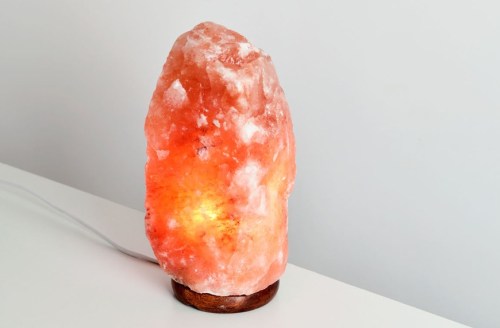Healthy or hype: Here’s how salt lamps actually work
Himalayan salt lamps have been attributed with being an easy and chic way to boost the health of your home. Here's what you need to know about how they work.

Himalayan salt’s been on the up and up for a couple of years now. From using it to season your food, to drinking it, and practicing yoga in salt chambers—the course pink crystal is *everywhere*, especially within the world of interior design where a Himalayan salt lamp has become the healthy home accent du jour.
Part of the popularity of the lamp is yes, that it looks like a crystal that magically emits light, but it’s also, in part, because of its purported healing powers. What exactly that process looks like is a metaphysical mystery to the average person, so I spoke to Joy Stephenson-Laws, JD at Proactive Health Labs, a health education non-profit, to get the rundown.
What are Himalayan salt lamps?
Although there are no technical limitations or FDA rulings on what constitutes an authentic Himalayan salt lamp, what it, in fact, refers to is a light bulb ensconced in a shell of very specific salt.
Real Himalayan salt comes from a specific area and set of mines in Khewra, Pakistan, which border the Himalayan mountains. The salt mines are millions of years old and are essentially the remnants of an evaporated inland ocean that, through some geological shifting, ended up being buried under a swathe of territory. The specific Khewra salt mine requires harvesters to descend 1,500 meters underground to collect crystals by hand from the 6.7 billion tons of salt hanging out underground.
A Himalayan salt lamp is thereby a lamp made from this very specific type of salt. One of the key ways to tell whether or not you have an authentic lamp is to leave it off for a period and see if the lamp begins to “cry” or emit a small puddle of water at its base, which is a specific feature of an authentic lamp.
How do Himalayan salt lamps work?
The benefits of these lamps revolve around the Himalayan salt’s ionization and hygroscopic properties—the latter being a sciencey sounding word that is used to describe all salts and means that it attracts moisture, humidity, and all other airborne water molecules.
Ions, on the other hand, are charged atoms and molecules that are at the core of the lamps health benefits. “Himalayan salt lamps are said to work by releasing negative ions” a process which is called negative air ionization according to Stephenson-Laws. And while the word “negative” has you know—a negative connotation, you actually want to have these around since “positive ions are actually harmful in excess and are emitted from things like toxic chemicals, pollution, and pet dander” Stephenson-Laws explains.
Himalayan salt lamps don’ in and of themselves release negative ions, to do this they need a heat source which is why the combined product of the salt lamp is considered to be healing, while a lamp and salt individually don’t exactly pose as a home-improvement item. The process through which the salt lamp attracts water and fluids that are then evaporated is how the negative ions are released.
But do Himalayan salt lamps actually work?
Since positive ions can negatively impact your health and come from toxic sources, salt lamps are thought to be air purifying through the ionization process, which, in turn, should help improve air quality, breathing, sleep, your immune system, and even your sleep.
How this holds up to science is where it gets tricky. There are numerous studies which have found evidence that the presence of positive ions can have a measurable impact on mood so much so that it has even been linked to depression and other psychological effects. So while the relationship between ions and health is scientifically proven “the evidence is not clear whether these lamps produce significant amounts of negatively charged ions to affect the health of humans” Stephenson-Laws says.
What to look for when you’re buying a salt lamp
Should you be a believer and follower of the woo-woo lifestyle, or just down for any placebo effect benefits, when you’re buying a lamp Stephenson-Laws advises that you make sure that it’s actually made from Himalayan salt from the Khewra mine (and not merely an aesthetic knockoff).
She also says it’s important to choose a lamp that’s an appropriate size for your room—if you have a small bedroom, find a lamp that is around 5 to 7 pounds. If you’re getting a lamp to change the vibes in a bigger space like your office or your living room, look for something that is between 40 and 50 lbs. Then, you know, let it glow.
If you’ve decided to buy one, here are some Himalayan salt lamps you can shop now and an intro to a different type of high-vibe healthy home accent, the selenite lamp.
Sign Up for Our Daily Newsletter
Get all the latest in wellness, trends, food, fitness, beauty, and more delivered right to your inbox.
Got it, you've been added to our email list.









